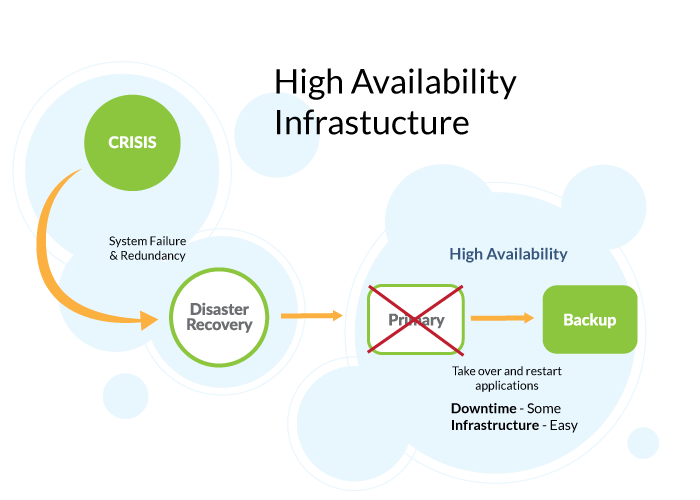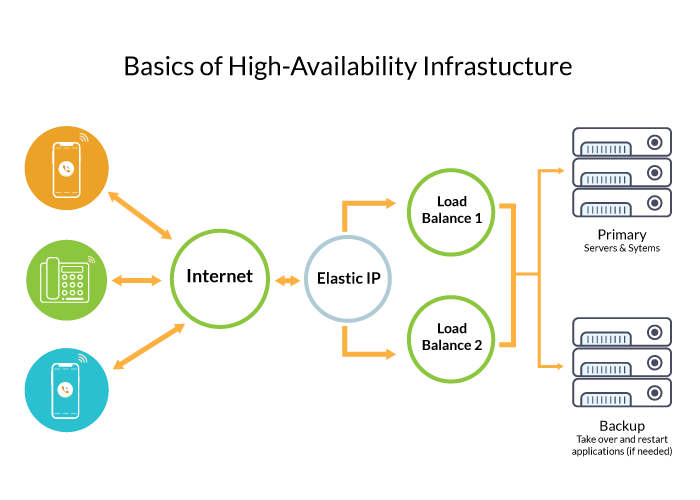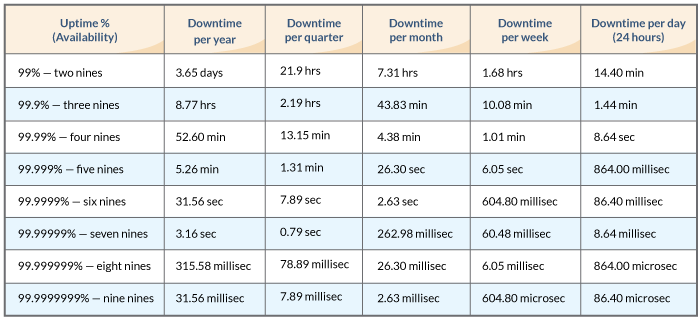When purchasing cloud services online, you might come across numbers like 99.999% uptime or 99.9% uptime. And as far as uptime goes, “99 point anything” should seem reliable enough. After all, it’s so close to 100%, so how much can it really be lacking? And what do those extra nines mean?
It’s a lot more than we think. To put it in perspective, 99.9% adds up to more than 8 hours of downtime a year, while 99.99999% adds up to only 3.15 seconds a year. Let that sink in for a minute.
Depending on your business, you may need a high-availability setup with little to no downtime. To determine what that looks like, we put together a guide to high-availability infrastructure to help you understand the specific differences between three 9s, four 9s, and five 9s.
Let’s dive in!
Understanding the 9s: Three 9s vs Four 9s vs Five 9s
Most service providers — including telecom providers — guarantee a certain percentage of uptime. This is also known as a Service Level Agreement (SLA). Uptime refers to the time a machine or system is in operation and actively working. Downtime, then, is when the machine or system is inactive or unavailable for use.
Downtimes can occur for a few different reasons:
- Electricity or internet outages
- Moving devices and equipment around
- Devices or equipment break down
- Natural disasters
- Updates and maintenance
- Hacking or cyberattacks, and so on.
And if you don’t have a valid disaster recovery plan in place, downtime can lead to significant service interruptions. This means your teams cannot complete tasks or communicate with each other. When your business is not accessible, you will lose out on providing reliable customer service.
To combat this issue and reduce potential downtime, it is recommended that businesses build voice redundancy (failover and backups) into their systems. One way to do this is by incorporating high-availability infrastructure and services.
What is a High-Availability Infrastructure?
High-availability infrastructure is designed to provide a level of operational performance and uptime that is higher than normal within a set time period. In simpler terms, high availability (HA) creates reliable systems that continue to operate with little to no downtime.
What does this look like?
A high-availability infrastructure is created by using clusters of servers — with failover options in place — to monitor each other. This way, if one server fails, the backup server will activate. It restarts applications that were active on the failed server and gets everything up and running again.

Basics of High-Availability Infrastructure
One of the foundations of creating high availability is eliminating single points of failure — an element of the system that, if it fails, causes everything in the system to fail.
To eliminate various single points of failure, most high-availability architecture look something like this at the base level:
- Traffic load is balanced between multiple servers with a load balancer. This way, when one server is offline, traffic is sent through the other server.
- Two load balancers provide additional support. This way, if one load balancer fails, traffic can failover to the other one.
- Since failover to a load balancer involves a Domain Name System (DNS) change, you may experience downtime. Solve this by adding a tool for rapid IP remapping. An Elastic IP can easily balance traffic between load balancers.

Understanding the 9s: Three 9s vs Four 9s vs Five 9s Uptime
So, what do the 9s have to do with anything? The 9s determine the amount of availability. In other words, three 9s availability or five 9s availability is the percentage of time a network or service is accessible to a user in a given period, usually a year.
During that period, your service will experience high uptime, while the remaining 0.0001% is the downtime you may experience.
Here’s a table comparing the different uptime percentages and how much downtime you might experience:

99.9% vs 99.99% vs 99.999% Uptime: What Does Your Business Need?
Now, 100% uptime is rare with complex systems. So, most services — cloud services in particular — will offer between 99% and 100% uptime.
Shouldn’t 99.9% uptime be enough?
In theory, yes, 99.9% uptime should be reliable enough. But as you can see above, it will still lead to about 3 days of downtime a year and almost a full day (21 hrs) per quarter.
But the uptime your business requires depends on your systems and service demands. So, the real question is…
How much downtime can you afford?
And can you add additional failover options in place to make up for that downtime? When deciding what high-availability infrastructure should look like for your business, consider these questions:
- How will my customers react if my service is down for 5 – 10 minutes? 1 – 3 hours? 12 hours to a full day?
- What percent of revenue will my business lose at those same intervals?
- Can I afford the costs of complex infrastructure?
- How does the value compare to the risks that come with additional complexity?
- Do I have the right people working to manage and scale the project?
- Do we have an updated incident management process and a disaster plan for when systems are down?
What 99.999% uptime means for your business?
The industry recognizes 99.9% and above as good and reliable uptime. But when you compare 99.9% vs 99.999% — it is safe to say that anything above the five 9s (99.999%) is excellent uptime and availability. This is because the most downtime you will experience in a year is a meager 5 mins.
How Do You Achieve a High-Availability Business Phone System?
There are 2 ways to create a high-availability infrastructure for your business phone system with high uptime:
1. Choose the right providers
Find a provider that has high availability or multiple layers of redundancy built into their systems.
When choosing a cloud telephony provider, ask about:
- Network reliability
- Failover capabilities
- How they prevent network interruptions
- Global voice coverage
- What happens if their service fails, and so on.
2. Set up redundancy in-house
Build geo-redundancy into your VoIP system and set up failover capabilities. Some ways to do this include:
- Add mission-critical applications and services within your network.
- Ask your in-house IT and operation teams to manage backup solutions, such as using additional hardware and equipment to mirror main systems.
- Buy equipment that is easy to use, repair, and update.
- Organize teams, agents, and call groups to function as backups.
- Automate wherever possible and monitor quality and performance.
- Consider hosting systems and teams in multiple geographic locations.
- Use advanced call routing strategies to forward calls to secondary destinations if the primary destination is unavailable. Failover forwarding, sequential ring, and simultaneous ringing will help you achieve this.
- Test backup and disaster recovery plans.
How Can Global Call Forwarding Help?
Global Call Forwarding offers 99.999% uptime through our high-availability and highly-redundant global network. We can maintain this level of availability and reliability because of a few different reasons:
- Multiple geo-redundant data centers spread globally
- Decades of industry expertise
- Long-term relationships built with local and global Tier-1 carriers, and more.
Find out if we are a good fit for your business by speaking with our telecom experts. Call us +1 (561) 908-6171 at or chat with us online today!



